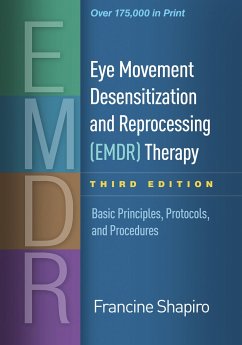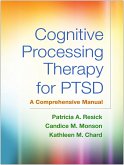Francine Shapiro (PhD (deceased) United States )
Eye Movement Desensitization and Reprocessing (Emdr) Therapy
Basic Principles, Protocols, and Procedures
Francine Shapiro (PhD (deceased) United States )
Eye Movement Desensitization and Reprocessing (Emdr) Therapy
Basic Principles, Protocols, and Procedures
- Gebundenes Buch
- Merkliste
- Auf die Merkliste
- Bewerten Bewerten
- Teilen
- Produkt teilen
- Produkterinnerung
- Produkterinnerung
The authoritative presentation of Eye Movement Desensitization and Reprocessing (EMDR) therapy, this groundbreaking book--now revised and expanded--has enhanced the clinical repertoires of more than 125,000 readers and has been translated into 10 languages.
Andere Kunden interessierten sich auch für
![Eye Movement Desensitization and Reprocessing (Emdr) Therapy Eye Movement Desensitization and Reprocessing (Emdr) Therapy]() Mark C. RussellEye Movement Desensitization and Reprocessing (Emdr) Therapy53,99 €
Mark C. RussellEye Movement Desensitization and Reprocessing (Emdr) Therapy53,99 €![Every Memory Deserves Respect Every Memory Deserves Respect]() Deborah KornEvery Memory Deserves Respect11,99 €
Deborah KornEvery Memory Deserves Respect11,99 €![Treating Complex Traumatic Stress Disorders in Children and Adolescents Treating Complex Traumatic Stress Disorders in Children and Adolescents]() Treating Complex Traumatic Stress Disorders in Children and Adolescents44,99 €
Treating Complex Traumatic Stress Disorders in Children and Adolescents44,99 €![The Trauma Recovery Group The Trauma Recovery Group]() Michaela MendelsohnThe Trauma Recovery Group43,99 €
Michaela MendelsohnThe Trauma Recovery Group43,99 €![Written Exposure Therapy for Ptsd Written Exposure Therapy for Ptsd]() Denise M. SloanWritten Exposure Therapy for Ptsd58,99 €
Denise M. SloanWritten Exposure Therapy for Ptsd58,99 €![Cognitive Processing Therapy for PTSD Cognitive Processing Therapy for PTSD]() Patricia A. Resick (United States Duke University Medical Center)Cognitive Processing Therapy for PTSD48,99 €
Patricia A. Resick (United States Duke University Medical Center)Cognitive Processing Therapy for PTSD48,99 €![Cognitive-Behavioral Therapy for Ptsd Cognitive-Behavioral Therapy for Ptsd]() Claudia Zayfert (United States EverMind)Cognitive-Behavioral Therapy for Ptsd58,99 €
Claudia Zayfert (United States EverMind)Cognitive-Behavioral Therapy for Ptsd58,99 €-
-
-
The authoritative presentation of Eye Movement Desensitization and Reprocessing (EMDR) therapy, this groundbreaking book--now revised and expanded--has enhanced the clinical repertoires of more than 125,000 readers and has been translated into 10 languages.
Produktdetails
- Produktdetails
- Verlag: Guilford Publications
- 3 ed
- Seitenzahl: 568
- Erscheinungstermin: 29. Dezember 2017
- Englisch
- Abmessung: 244mm x 164mm x 35mm
- Gewicht: 950g
- ISBN-13: 9781462532766
- ISBN-10: 1462532764
- Artikelnr.: 48095175
- Herstellerkennzeichnung
- Libri GmbH
- Europaallee 1
- 36244 Bad Hersfeld
- gpsr@libri.de
- Verlag: Guilford Publications
- 3 ed
- Seitenzahl: 568
- Erscheinungstermin: 29. Dezember 2017
- Englisch
- Abmessung: 244mm x 164mm x 35mm
- Gewicht: 950g
- ISBN-13: 9781462532766
- ISBN-10: 1462532764
- Artikelnr.: 48095175
- Herstellerkennzeichnung
- Libri GmbH
- Europaallee 1
- 36244 Bad Hersfeld
- gpsr@libri.de
Francine Shapiro, PhD, until her death in 2019, was Senior Research Fellow Emeritus at the Mental Research Institute in Palo Alto, California; Executive Director of the EMDR Institute in Watsonville, California; and founder and President Emeritus of the Trauma Recovery/EMDR Humanitarian Assistance Programs, a nonprofit organization that coordinates disaster response and pro bono trainings worldwide. The originator and developer of EMDR therapy, Dr. Shapiro was a recipient of the International Sigmund Freud Award for distinguished contribution to psychotherapy, presented by the City of Vienna in conjunction with the World Council for Psychotherapy; the Award for Outstanding Contributions to Practice in Trauma Psychology from Division 56 of the American Psychological Association; and the Distinguished Scientific Achievement in Psychology Award from the California Psychological Association. Dr. Shapiro was designated as one of the "Cadre of Experts" of the American Psychological Association and the Canadian Psychological Association Joint Initiative on Ethnopolitical Warfare and served as advisor to a wide variety of trauma treatment and outreach organizations and journals. She was an invited speaker at psychology conferences worldwide and published more than 90 articles, chapters, and books about EMDR.
1. Background
2. Adaptive Information Processing: The Model as a Working Hypothesis
3. Components of EMDR Therapy and Basic Treatment Effects
4. Phase One: Client History
5. Phases Two and Three: Preparation and Assessment
6. Phases Four to Seven: Desensitization, Installation, Body Scan, and
Closure
7. Working with Abreaction and Blocks
8. Phase Eight: Reevaluation and Use of the EMDR Therapy Standard
Three-Pronged Protocol
9. Standardized Protocols and Procedures for Special Situations
10. The Cognitive Interweave: A Proactive Strategy for Working with
Challenging Clients
11. Selected Populations
12. Theory, Research, and Clinical Implications
References
Appendix A. Clinical Aids
Appendix B. Client Transcripts
Appendix C. Clinical and Outcome Assessments
Appendix D. Research Lists
Appendix E. Client Safety
Appendix F. EMDR Therapy Training Resources
Index
2. Adaptive Information Processing: The Model as a Working Hypothesis
3. Components of EMDR Therapy and Basic Treatment Effects
4. Phase One: Client History
5. Phases Two and Three: Preparation and Assessment
6. Phases Four to Seven: Desensitization, Installation, Body Scan, and
Closure
7. Working with Abreaction and Blocks
8. Phase Eight: Reevaluation and Use of the EMDR Therapy Standard
Three-Pronged Protocol
9. Standardized Protocols and Procedures for Special Situations
10. The Cognitive Interweave: A Proactive Strategy for Working with
Challenging Clients
11. Selected Populations
12. Theory, Research, and Clinical Implications
References
Appendix A. Clinical Aids
Appendix B. Client Transcripts
Appendix C. Clinical and Outcome Assessments
Appendix D. Research Lists
Appendix E. Client Safety
Appendix F. EMDR Therapy Training Resources
Index
1. Background
2. Adaptive Information Processing: The Model as a Working Hypothesis
3. Components of EMDR Therapy and Basic Treatment Effects
4. Phase One: Client History
5. Phases Two and Three: Preparation and Assessment
6. Phases Four to Seven: Desensitization, Installation, Body Scan, and
Closure
7. Working with Abreaction and Blocks
8. Phase Eight: Reevaluation and Use of the EMDR Therapy Standard
Three-Pronged Protocol
9. Standardized Protocols and Procedures for Special Situations
10. The Cognitive Interweave: A Proactive Strategy for Working with
Challenging Clients
11. Selected Populations
12. Theory, Research, and Clinical Implications
References
Appendix A. Clinical Aids
Appendix B. Client Transcripts
Appendix C. Clinical and Outcome Assessments
Appendix D. Research Lists
Appendix E. Client Safety
Appendix F. EMDR Therapy Training Resources
Index
2. Adaptive Information Processing: The Model as a Working Hypothesis
3. Components of EMDR Therapy and Basic Treatment Effects
4. Phase One: Client History
5. Phases Two and Three: Preparation and Assessment
6. Phases Four to Seven: Desensitization, Installation, Body Scan, and
Closure
7. Working with Abreaction and Blocks
8. Phase Eight: Reevaluation and Use of the EMDR Therapy Standard
Three-Pronged Protocol
9. Standardized Protocols and Procedures for Special Situations
10. The Cognitive Interweave: A Proactive Strategy for Working with
Challenging Clients
11. Selected Populations
12. Theory, Research, and Clinical Implications
References
Appendix A. Clinical Aids
Appendix B. Client Transcripts
Appendix C. Clinical and Outcome Assessments
Appendix D. Research Lists
Appendix E. Client Safety
Appendix F. EMDR Therapy Training Resources
Index








